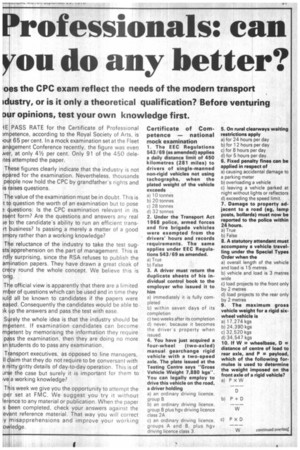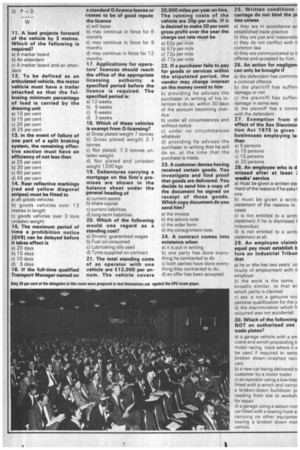Professionals: can You do any better?
Page 53

Page 54

If you've noticed an error in this article please click here to report it so we can fix it.
oes the CPC exam reflect the needs of the modern transport idustry, or is it only a theoretical qualification? Before venturing Dur opinions, test your own knowledge first.
-1E. PASS RATE for the Certificate of Professional )moetence, according to the Royal Society of Arts, is out 65 per cent. In a mock examination se/ at the Fleet anagement Conference recently, the figure was even tier, at only 41/2 per cent. Only 91 of the 450 deletes attempted the paper.
These figures clearly indicate that the industry is not epared for the examination. Nevertheless, thousands people now hold the CPC by grandfather's rights and is raises questions.
The value of the examination must be in doubt. This is t to question the worth of an examination but to pose questions: Is the CPC examination relevant in its asent form? Are the questions and answers any real ie to the candidate's ability to run an efficient transrt business? Is passing a merely a matter of a good ?mory rather than a working knowledge?
The reluctance of the industry to take the test sugsts apprehension on the part of management. This is rdly surprising, since the RSA refuses to publish the amination papers. They have drawn a great cloak of crecy round the whole concept. We believe this is .ong The official view is apparently that there are a limited mber of questions which can be used and in time they )uld all be known to candidates if the papers were eased. Consequently the candidates would be able to )k up the answers and pass the test with ease.
Surely the whole idea is that the industry should be mpetent. If examination candidates can become mpetent by memorising the information they require pass the examination, then they are doing no more 3n students do to pass any examination.
Transport executives, as opposed to line managers, II claim that they do not require to be conversant with e nitty gritty details of day-to-day operation. This is of Jrse the case but surely it is important for them to lye a working knowledge?
This week we give you the opportunity to attempt the per set at FMC. We suggest you try it without ference to any material or publication. When the paper s been completed, check your answers against the evant reference material. That way you will correct y misapprehensions and improve your working owledge. Certificate of Competence — national mock examination
1. The EEC Regulations 543/69 (as amended) applies a daily distance limit of 450 kilometres (281 miles) to drivers of single-manned non-rigid vehicles not using tachographs, when the plated weight of the vehicle exceeds a) 10 tonnes b) 20 tonnes c) 28 tonnes d) 32 tonnes 2. Under the Transport Act 1968 police, armed forces and fire brigade vehicles were exempted from the drivers' hours and records requirements. The same applies under EEC Regulations 543/69 as amended.
a) True b) False 3. A driver must return the duplicate sheets of his individual control book to the employer who issued it to him a) immediately it is fully completed b) within seven days of its completion c) two weeks after its completion d) never, because it becomes the driver's property when issued.
4. You have just acquired a four-wheel (two-axled) manual gearchange rigid vehicle with a two-speed axle. The plate issued at the Testing Centre says "Gross Vehicle Weight 7,880 kgs". You can legally employ to drive this vehicle on the road, a driver holding a) an ordinary driving licence, group B b) an ordinary driving licence, group B plus hgv driving licence class 2A C) an ordinary driving licence. groups A and B, plus hgv driving licence class 3. 5. On rural clearways waiting restrictions apply a) for 24 hours per day b) for 12 hours per day c) for 8 hours per day d) for 5 hours per day.
6. Fixed penalty fines can be applied in respect of a) causing accidental damage to a parking meter b) overloading a vehicle c) leaving a vehicle parked at night without lights or reflectors d) exceeding the speed limit.
7. Damage to property adjacent to a road (eg, lamp posts, bollards) must now be reported to the police within 24 hours.
a) True b) False 8. A statutory attendant must accompany a vehicle travelling under the Special Types Order when the a) overall length of the vehicle and load is 15 metres b) vehicle and load is 3 metres wide c) load projects to the front only by 2 metres d) load projects to the rear only by 2 metres 9. The maximum gross vehicle weight for a rigid sixwheel vehicle is a) 17,274 kgs b) 24,390 kgs c) 32,520 kgs d) 34,547 kgs 10. If W = wheelbase, D = distance of centre of load to rear axle, and P = payload, which of the following formulae is used to determine the weight imposed on the front axle of a rigid vehicle?
a) PXW --D 11. A load projects forward of the vehicle by 3 metres. Which of the following is required?
a) A marker board b) An attendant c) A marker board and an attendant 12. To be defined as an articulated vehicle, the motor vehicle must have a trailer attached so that the following minimum percentage of load is carried by the drawing unit a) 10 per cent b) 15 per cent c) 20 per cent d) 25 per cent 13. in the event of failure of one part of a split braking system, the remaining effective section must have an efficiency of not less than a) 25 per cent b) 30 per cent c) 40 per cent d) 45 per cent 14. Rear reflective markings (red and yellow diagonal stripes) must be fitted to a) all goods vehicles b) goods vehicles over 13 metres in length c) goods vehicles over 3 tons unladen weight.
15. The maximum period of time a prohibition notice (GV9) can be delayed before it takes effect is a) 20 days b) 15 days c) 10 days d) 5 days 16. If the full-time qualified Transport Manager named on a standard 0-licence leaves or ceases to be of good repute the licence a) will lapse b) may continue in force for 6 months c) may continue in force for 9 months d) may continue in force for 12 months 17. Applications for operators' licences should reach the office of the appropriate licensing authority a specified period before the licence is required. The specified period is: a) 12 weeks b) 9 weeks c) 6 weeks d) 3 weeks 18. Which of these vehicles is exempt from 0-licensing?
a) Gross plated weight 7 tonnes b) Gross plated weight 3.7 tonnes c) Not plated, 7.3 tonnes unladen weight d) Not plated and unladen weight 1200 kgs.
19. Debentures carrying a mortgage on the firm's premises are shown in the balance sheet under the general heading of a) current assets b) share capital c) current liabilities d) long-term liabilities.
20. Which of the following would one regard as a standing cost?
a) Drivers guaranteed wages b) Fuel oil consumed c) Lubricating oils used d) Tyres supplied on contract.
21. The total standing costs of an operator with one vehicle are £12,000 per annum. The vehicle covers 30,000 miles per year on hire. The running costs of the vehicle are 20p per mile. If it is desired to make 20 per cent gross profit over the year the charge out rate must be a) 62p per mile b) 67p per mile c) 72p per mile d) 77p per mile 22. If a purchaser fails to pay for goods or services within the stipulated period, the vendor may charge interest on the money owed to him a) providing he advises the purchaser in writing of his intention to do so, within 30 days of the account becoming overdue b) under all circumstances and without notice c) under no circumstances whatever d) providing he advises the purchaser in writing that he will do so, at the time that the purchase is made.
23. A customer denies having received certain goods. You investigate and find proof that goods are delivered. You decide to send him a copy of the document he signed on receipt of those goods. Which copy document do you send him?
a) the invoice b) the advice note c) the order form d) the consignment note.
24. A contract comes into existence when a) it is put in writing b) one party has done everything he contracted to do c) both parties have done everything they contracted to do d) an offer has been accepted. 25. Written conditions 1 carriage do not bind the p, ties unless a) they are in accordance wi established trade practice b) they are just and reasonablE c) they do not conflict with tl common law d) they are communicated to tl offeree and accepted by him, 26. An action for negligem can only be brought if a) the defendant has commith a criminal offence b) the plaintiff has suffer( damage or not c) the plaintiff has suffer( damage in some way d) the plaintiff has a contra with the defendant.
27. Exemption from tl effect of the Sex Discrimin tion Act 1975 is given businesses employing In: than a) 5 persons b) 10 persons c) 15 persons d) 20 persons 28. An employee who is d missed after at least : weeks' service a) must be given a written sta• ment of the reasons if he asks I one b) must be given a writti statement of the reasons in cases c) is not entitled to a writti statement if he is dismissed f misconduct d) is not entitled to a writti statement at all.
29. An employee claim'', equal pay must establish b fore an Industrial Tribun that a) he or she has two years' co tinuity of employment with tl employer b) the work is the same, broadly similar, to that vvi which parity is claimed c) sex is not a genuine occ pational qualification for the j( d) the discrimination which h occurred was not accidental.
30. Which of the following NOT an authorised use trade plates?
a) a garage vehicle with a sm crane and winch proceeding t( motor racing track where it v, be used if required to remo broken down /crashed racii cars
b) a new car being delivered t( customer by a motor trader c) an operator using a low-loac fitted with a winch and carryii a broken-down bulldozer pr ceeding from site to workshi for repair d) a garage using a saloon moi car fitted with a towing hook ai carrying no other equipmer towing a broken down mot vehicle.
























































































































